The Nativity of Christ (Christmas) is easily one of the most important and most celebrated feasts in both the Eastern and Western Churches. This mystery is noted for its great joy. The heavens rejoice, the shepherds race to welcome their new king and the magi come bearing gifts. But in this mystery we can also find sorrow. We find that we still live in a “not yet” reality that desperately longs for our full redemption as the sons of God. In the East, the icon of the Nativity is an image that gives us a much fuller picture of this event than any modern Western art with its calm and sweet imagery.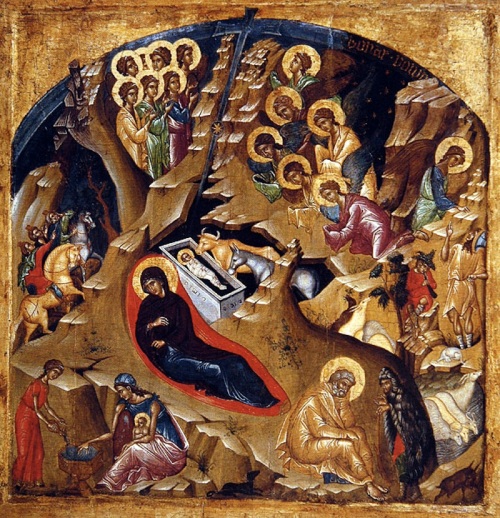
In the icon, we see Jesus and Mary as the focal points around which everything else is based. Mary is reclined upon a red cloth having performed the act of giving birth. The red cloth represents life, which Mary gives to all believers by her obedience and labor. Just as Eve was named the Mother of the Living, so Mary is the mother of the new humanity that will be united and deified in Christ. To her right is Jesus in the midst of the cave, in which Jesus (according to tradition) was born. Jesus is wrapped in swaddling clothes and laid in a manger, but the way in which he is portrayed is symbolic. Jesus is wrapped in cloths, strongly evocative of his burial; the manger is made of stone and shaped more like a grave, reminding us that even at the beginning of his earthly life, Jesus was already prepared to die and rise. 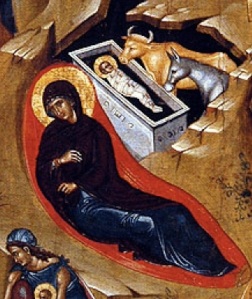 Jesus is in the mist of the dark cave reminding us that Jesus, the Author of Life, descended into sin and death to raise us up. Around him is an ox and a donkey which hearkens back to Isaiah 1:3 which states, “The ox knows its owner, and the donkey its master’s crib; but Israel does not know, my people does not understand.” The animals also represent all of creation, which “waits with eager longing for the revealing of the sons of God; for the creation was subjected to futility, not of its own will but by the will of him who subjected it in hope; because the creation itself will be set free from its bondage to decay and obtain the glorious liberty of the children of God.” (Rom 8:19-20) Creation has been waiting for its redemption from sin as well.
Jesus is in the mist of the dark cave reminding us that Jesus, the Author of Life, descended into sin and death to raise us up. Around him is an ox and a donkey which hearkens back to Isaiah 1:3 which states, “The ox knows its owner, and the donkey its master’s crib; but Israel does not know, my people does not understand.” The animals also represent all of creation, which “waits with eager longing for the revealing of the sons of God; for the creation was subjected to futility, not of its own will but by the will of him who subjected it in hope; because the creation itself will be set free from its bondage to decay and obtain the glorious liberty of the children of God.” (Rom 8:19-20) Creation has been waiting for its redemption from sin as well.
 Above the crib we see a mandorla representing both the divine presence and the star over Bethlehem. The star is found within the ray, offered by God to point the Magi (to the left on horseback) on to Bethlehem. The three Wise Men vary with age, one having white hair and a beard, the middle having brown hair and a beard, and the closest having no beard. This expresses to us that wisdom is not a matter of age but of the heart.
Above the crib we see a mandorla representing both the divine presence and the star over Bethlehem. The star is found within the ray, offered by God to point the Magi (to the left on horseback) on to Bethlehem. The three Wise Men vary with age, one having white hair and a beard, the middle having brown hair and a beard, and the closest having no beard. This expresses to us that wisdom is not a matter of age but of the heart.
Above the Wise Men we see the angelic choir, some of whom are looking toward the mandorla in praise of God, some of whom look toward each other (recalling the fact that the Angels speak the praise of God to one another in Isaiah 6:3), some who adore Christ, and one who is telling the news to the shepherds (to the right). One of the shepherds plays the flute (expressing his joy) next to a tree that represents the tree of Jessi, who is the father of David and ancestor of Jesus. In the Magi and in the Shepherds, we see the invitation of many classes of people- the rich and the poor, rulers and subjects, Jews and Gentiles- to the worship of Christ the Lord with Heaven and Earth.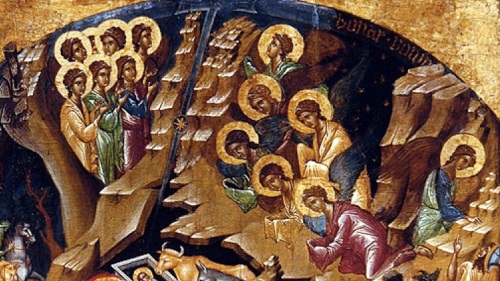
 To the bottom left, we see two midwives who wash Jesus, showing that his birth happened by natural means and thus shows his humanity. The midwives’ arms are bare due to a tradition that Joseph approached them and asked them to tend to the Son of God. When they mocked him their arms withered because of their unbelief but when they came to clean Jesus their arms were restored back to their normal state. We see in this that before we come to believe in Christ, we come disfigured by sin and disbelief but we are made whole by Christ.
To the bottom left, we see two midwives who wash Jesus, showing that his birth happened by natural means and thus shows his humanity. The midwives’ arms are bare due to a tradition that Joseph approached them and asked them to tend to the Son of God. When they mocked him their arms withered because of their unbelief but when they came to clean Jesus their arms were restored back to their normal state. We see in this that before we come to believe in Christ, we come disfigured by sin and disbelief but we are made whole by Christ.
 Finally, to the bottom right we find Joseph, apart from Jesus and Mary because he did not have a role in this miracle, but only acted as their protector. Joseph sits in a pensive, perhaps even a despondent, posture. He is approached by an old man who, in the iconographic tradition, is the devil. The devil here is trying to convince Joseph that this birth is not a miracle (why would God enter the world in this way?), that Jesus is not the Son of God, and that Mary was unfaithful to him. This reminds us that the miraculous birth of Christ, even for a holy man like Joseph, is not a thing of reason but of faith, which cannot be fully grasped. This struggle of Joseph is not resolved in this image, but will find its answer in another icon.
Finally, to the bottom right we find Joseph, apart from Jesus and Mary because he did not have a role in this miracle, but only acted as their protector. Joseph sits in a pensive, perhaps even a despondent, posture. He is approached by an old man who, in the iconographic tradition, is the devil. The devil here is trying to convince Joseph that this birth is not a miracle (why would God enter the world in this way?), that Jesus is not the Son of God, and that Mary was unfaithful to him. This reminds us that the miraculous birth of Christ, even for a holy man like Joseph, is not a thing of reason but of faith, which cannot be fully grasped. This struggle of Joseph is not resolved in this image, but will find its answer in another icon.
This image communicates to us a reality- that even here, at this moment of great joy, we find that we look forward to the Death and Resurrection of Christ. Even now we still await our the total redemption of our bodies in our “not yet” universe of sin, pain and death. Yet in all the midst of this, we see Christ shining in the darkness, showing us the way to the Father.


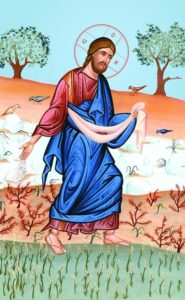 St. Nectarios Adult Retreat hosted
St. Nectarios Adult Retreat hosted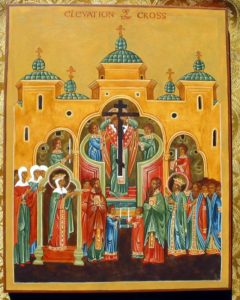

![Transfiguration[1]](https://holytrinitydanbury.org/wp-content/uploads/2016/08/Transfiguration1-300x300.jpg)